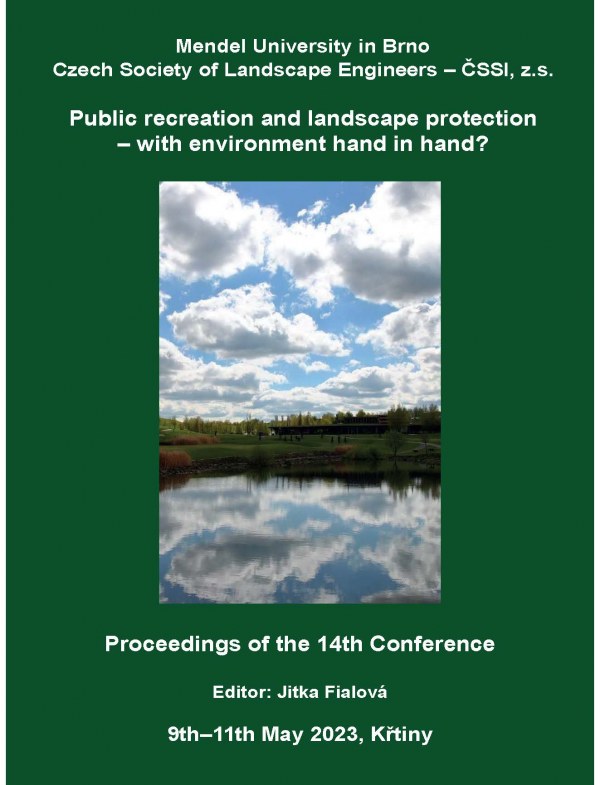
DOI: 10.11118/978-80-7509-904-4-0101
CHANGE OF THE WAY THAT LANDSCAPE IS USED AND IT IS EFFECT ON THE RECREATIONAL AND TOURIST POTENTIAL
- Jan Szturc, Jan Prachowski, Jana Podhrázská, Petr Karásek, Josef Kučera
Dirt roads and footpaths together with landscape elements form a landscape mosaic. As the density of the dirt road network increases, the fragmentation of the landscape increases. The landscape is becoming more varied and, above all, more accessible, whether for the management of agricultural land or free tourism and recreation. This article deals with the analysis of the historical development of transport infrastructure on the example of the Vilémovice u Macochy model area - part of the Moravian Karst protected area. The Moravian Karst belongs to the most important karst areas in the Czech Republic and also in central Europe. The Macocha gorge, which is frequently visited by tourists is located in the area of interest. The territory is also crossed by the Moravskoslezská svatojakubská tourist Route and Srdcem jižní Moravy cycle Route. It is a popular tourist and recreational area. The density of the road network and its quality indicate the degree of recreational and tourist development of the region. The network of dirt roads in the open countryside has undergone significant changes in the last century. Unfortunately, the roads got in the way of this trend. This resulted in an inaccessible and impenetrable landscape. Recently, this trend is reversing and new dirt roads are being designed and implemented. These are mainly implemented as part of the land consolidation process. The newly realized roads serve to make land available for land owners, for agricultural production, transport and to make the landscape more accessible. Harmonious integration of existing and newly implemented dirt roads into the landscape is important, including the selection of appropriate.
Keywords: dirt road, landscape fragmentation, land consolidation, land ownership, tourism, recreation
pages: 101-105, Published: 2023, online: 2023
References
- Boston, K. (2016). Potenciální vlivy lesních cest na životní prostředí a zmírňování jejich dopadů. Curr. Forestry Rep, 2, 215-222. DOI: https://doi.org/10.1007/s40725-016-0044-x
 Go to original source...
Go to original source... - Karásek, P., Podhrázská, J., Konečná, J., Kučera, J., Pochop, M. (2017). Pozemkovými úpravami měníme tvář krajiny. Agrobase zpravodaj 6/2017 [online]. Available at: https://www.researchgate.net/publication/330701860_Pozemkovymi_upravami_menime_tvar_krajiny
- Monz, C. A., Gutzwiller, K. J., Hausner, V. H. et al. (2021). Pochopení a řízení vzájemného působení dopadů rekreace v přírodě a změny klimatu. Ambio 50, 631-643. DOI: https://doi.org/10.1007/s13280-020-01403-y.
 Go to original source...
Go to original source... - Palatková, M., Zichová, J. (2014). Ekonomika turismu: turismus České republiky. 2. aktualiz. a rozš. vyd. Praha: Grada. ISBN 978-80-247-3643-3.
- Ředitelství dálnic a silnic ČR. (2023). Mapa silniční a dálniční sítě Jihomoravského kraje. Ředitelství dálnic a silnic ČR [online]. Available at: https://rsdcr.maps.arcgis.com/apps/instant/sidebar/index.html?appid=fd2664f7a1c94535a79afa88587d16f4 [Accessed: 2023-02-17].
- Yemshanov, D., Haight, R. G., Liu, N. et al. (2022). Exploring the tradeoffs among forest planning, roads and wildlife corridors: a new approach. Optim. Lett., 16, 747-788. DOI: https://doi.org/10.1007/s11590-021-01745-w.
 Go to original source...
Go to original source...


